How One Tragic Event Led to 50 Years of Life-Saving Research
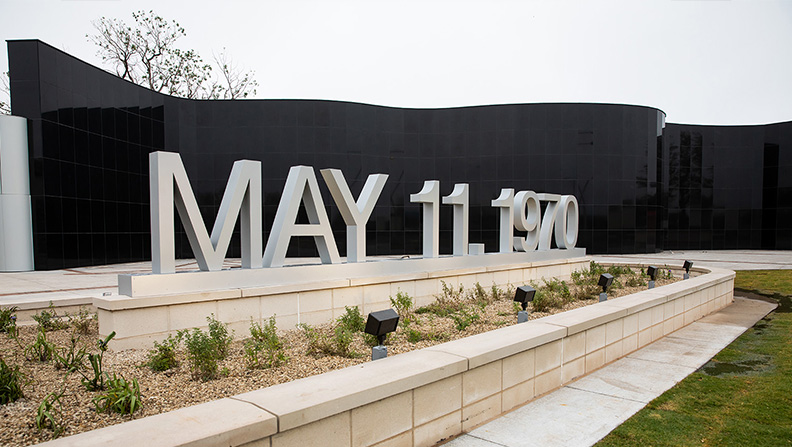
Texas Tech Researchers Respond to Community Needs in Wind Research
Texas Tech University researchers were inspired to start one of their most successful and ongoing research efforts after a deadly tornado in 1970, when they realized that rather than gathering data in a laboratory, they could collect data on the streets of Lubbock, Texas.
It was, as is common at Texas Tech, an effort rooted in response to the needs of the community.
According to Kishor Mehta, one of several young researchers from the Texas Tech's Department of Civil Engineering when the tornado hit Lubbock, it didn't do much damage to the university, then Texas Technological College. But the 1970 tornado was deadly to Lubbock residents just east of campus.
But the efforts of the researchers in the days that followed changed the direction of his entire career, led to improvements in building standards and in how to judge tornado damage, and led Texas Tech to create the National Wind Institute. That institute now works on wind engineering, development of energy systems using wind, and atmospheric measurement and simulation.
Texas Tech Aimed to Ramp Up Research
While working on his doctorate at the University of Texas at Austin, Mehta's advisor told him about a relatively new institution in West Texas which was just ramping up its research programs.
Mehta ended up at Texas Technological College in 1964, when the university was only about 40 years old. There was no structures laboratory, so he would have some input into what would be needed for that facility, where he thought he would test structural components.
“My (department) chairman had promised that when I came, that we would establish a structural engineering laboratory. The first couple of years, we just kind of conducted a little bit of testing in the lab, as much as we could,” Mehta said, describing the situation before the lab was built as challenging. “It was a fun thing, because I was able to do what I wanted to do and design the lab the way we wanted it. So, this is the part of the attraction to coming to Texas Tech.”
The Lab: They Built It, but a Tornado Came
As it turned out, a lot of his research did not come from inside a lab. Instead, he turned out to be in the right place at the right time with his eyes open to see an opportunity to do impactful research outside of a lab.
Some of his earliest efforts were at the Jones Stadium, where he noted that the lights blew down in West Texas winds in 1968. He and another professor, James McDonald, placed sensors on the new lights to test impact of wind on flexible structure.
“That was our first attempt at what I would consider to be the real research. But we were not funded for it,” Mehta said. He said he borrowed the equipment from another department to collect data.
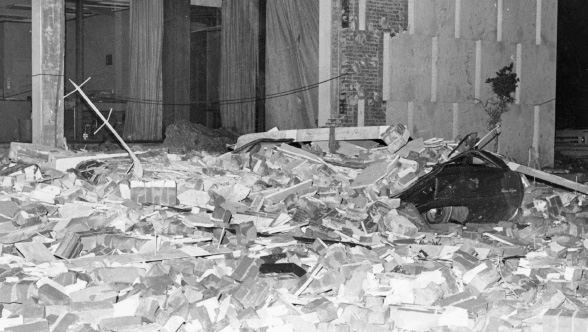
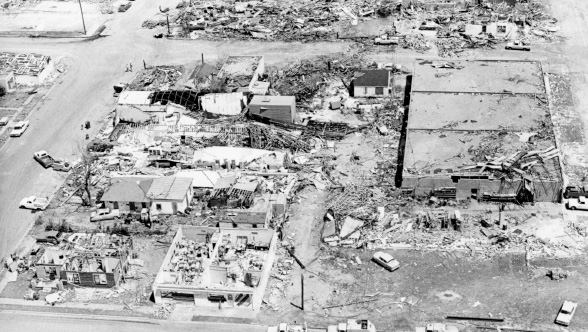
Just two years later in 1970, he and other engineering professors noted that while a deadly tornado did not do a lot of damage to the Texas Tech campus, there was a lot of damage just east of the college.
Mehta was at home that night grading final exams, but the morning following the May 11, 1970 tornado, he came to campus and heard about the extensive damage.
“The next morning when I came to the university, at that time, some information came out that it was a very severe tornado, and it had done a lot of damage to different types of buildings,” he said. “What triggered in my mind was that nature has done the testing for us. It is not a controlled testing like in the laboratory, but there is a lot of testing done, so there will be value in documenting that damage.”
Ernst Kiesling was named the chairman of the civil engineering department in 1969, and although he died in 2021, he talked a year earlier at the 50th anniversary of the Lubbock tornado about that time period when he came to Texas Tech to build a research program in civil engineering.
“We had a young faculty, including Mehta, (Jim) McDonald, Joe Minor, and some other people who were looking for research areas, but we had very little going,” Kiesling said. “I viewed my appointment as chairman of civil engineering more or less as a mandate to develop a research program, because we had a graduate program in place, but no research to support it. The tornado provided a laboratory for us because there were lots of damaged buildings. We immediately went to work, and that was the start of the wind engineering program.”
A day after the tornadoes, Ted Fujita, a severe storms researcher and meteorologist from the University of Chicago, came to Lubbock to also assess the damage. The data he gathered from Lubbock and other sites helped him to officially develop the Fujita Scale in 1971. That scale ranked the strength and power of tornadoes based on wind speed and the damage caused by wind. At that time, the Fujita scale ranked tornadic storms from F-0 to F-5.
Researchers Became ‘Annoyingly Expert'
Mehta worked with McDonald, Minor, Al Sanger, and Cliff Parish, as well as then-chairman Kiesling, to document and analyze the damage from the tornado. Ultimately, they spent a year investigating and writing a 400-page report on the tornado damage, which they later realized was one of the most detailed reports of its kind at that time.
“That kind of got our name at the national level. We were doing some work that was good,” Mehta said.
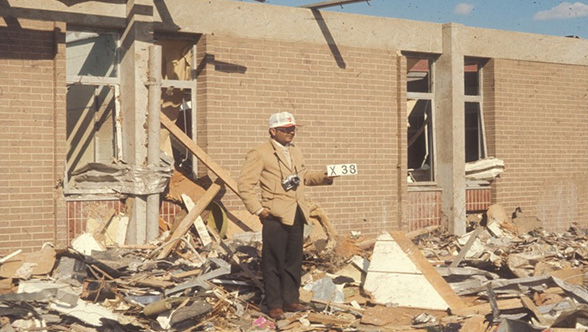
This led to the professors going to the scene of other weather events, with some funding for research from the National Science Foundation. Mehta said Minor was from the Corpus Christi area, so he went back there to document damage from a Hurricane Celia, which led the professors to the realization that hurricane damage was very similar to tornado damage.
“Whenever there was a tornado in the surrounding area, we would go out and do the damage investigation,” Mehta said. Soon they were going farther away to investigate tornado damage in other states, including a super outbreak of tornadoes in 1974 that saw Mehta go to Xenia, Ohio, while McDonald went to Paducah, Kentucky, and Minor went to Illinois.
The Ohio town hit by a tornado was much smaller than Lubbock but had similar fatalities even though the population was lower, Mehta said.
“It was a very severe tornado,” he said. “I did an investigation there looking at the schools. At that time, we had no way of knowing just what would be the wind speed in tornadoes. Now we still are judging the wind speed rather than measuring the wind speed.”
Mehta said the work led to the group becoming “annoyingly expert” at tornado damage investigation.
The researchers got funding from NSF, the Department of Civil Preparedness Agency, and the Nuclear Regulatory Commission, which was interested in making sure a tornado would not take out a nuclear facility. Mehta speaks frequently of Minor, McDonald, and Kiesling, noting that they all worked together through what is now the National Wind Institute. He said he, Minor, and McDonald regularly looked out for possible funding for each other's projects.
Researchers ‘Collaborated' Before It Was a Buzzword
John Schroeder is the senior director of the National Wind Institute at Texas Tech, and he continues with research in the Texas Tech Hurricanes at Landfall Project. He's also a former Texas Tech student, having come to the university to study with Peterson after working on his undergraduate degree under the mentorship of Minor, who later in his career worked at the University of Missouri at Rolla.
As a student, he observed that there was a group of people at Texas Tech that were willing to work together in a lot of ways that maybe others would not do.
“They were just all so darned friendly and open to each other. They started to work together, and because of their infectious personalities, I think what happened was, the group continued to grow.”
“They were just all so darned friendly and open to each other. They started to work together, and because of their infectious personalities, I think what happened was, the group continued to grow,” Schroeder said.
Mehta said he, Minor and McDonald frequently worked together, helping out with each other's research by promoting it to groups that they later got funding from, such as the National Science Foundation, the U.S. Department of Civil Preparedness Agency, and the Nuclear Regulatory Commission.
“For example, if I were going to Washington for some meeting, I would tell Joe and Jim, ‘Do you have something that I can go and show to the NSF program director? Can I promote your program or what you're doing, or can I go and see the people at NRC that would help you?'” Mehta said. “Then Joe was going, and he asked me, ‘Who do you want me to go and see?' Three of us worked together, all along.”
While civil engineers may have started the initial work from a structural viewpoint in 1970, atmospheric scientists were soon on board. Later, Schroeder said people from economics, architecture, mathematics, other engineering specialties, and even business all became involved in wind research.
“So that group became very multi-disciplinary, not because it was mandated by some award…It just happened organically. As people started to add capabilities to the mix, the group grew. It became obvious, it started with tornadoes, and became tornadoes and hurricanes very quickly, and it then became wind in general,” Schroeder said.
Mehta said the scientists realized it was going to take a multi-pronged approach to understand wind and its effects.
“No one single discipline would be able to solve the problem,” Mehta said.
The Research Had an Impact
Mehta said they wanted to put Lubbock and Texas Tech on the map with their research. With the eventual creation of the National Wind Institute, and its work to understand wind, create building standards that will resist wind, and harness the wind for energy, they succeeded.
“It really definitely made an impact,” Mehta said of the group's research.
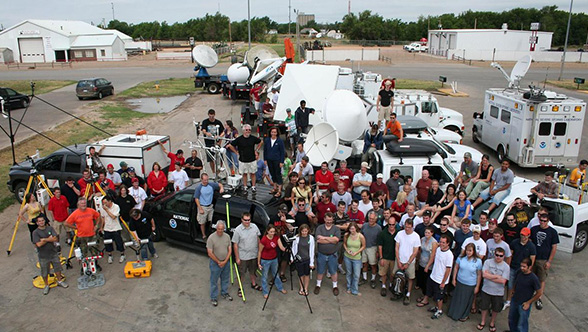
At one point, he went to Florida to investigate storm damage in a school in which the gymnasium collapsed. He said a teacher of young children moved her students into the hallway during a tornado because of information the school was given from the National Weather Service.
“I inspected that gymnasium. If she had not moved the children to the hallway, we would have received the fatalities of several young people,” he said. “What kills people is not the wind, but the building collapsing on them.”
Having better information based on investigations into previous storms may have saved those children's lives, Mehta said.
Schroeder said that sort of information was crucial, as was Kiesling's research into above-ground storm shelters. Schroeder calls Kiesling “the grandfather of above-ground storm shelters,” or reinforced interior rooms that can help people to shelter in place.
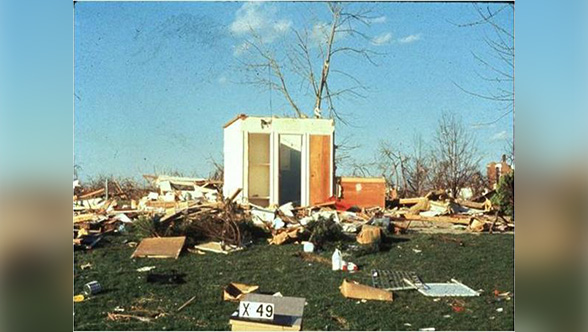
“I think about the legacy that he left: He saved lives,” Schroeder said of Kiesling's work.
Mehta and McDonald also picked up on the research done by Fujita in the 1970s. In 2006, improvements to the Fujita Scale were unveiled by the National Weather Service after being developed at Texas Tech. People throughout the United States and Canada are familiar with news reports on storms using the Enhanced Fujita Scale, or EF-Scale, which rates storms on the severity of the damage they cause.
The Research Continues
Through new blood at the National Wind Institute, research continues into wind that causes damage and wind that could power the world.
While at one time, attitudes towards tornado fatalities were fatalistic, Mehta said because of research into which structures take damage in tornadoes, buildings can be made more safely now.
“Chances of surviving tornadoes are very high,” Mehta said, adding that in the future, things will be even safer because of ongoing research.
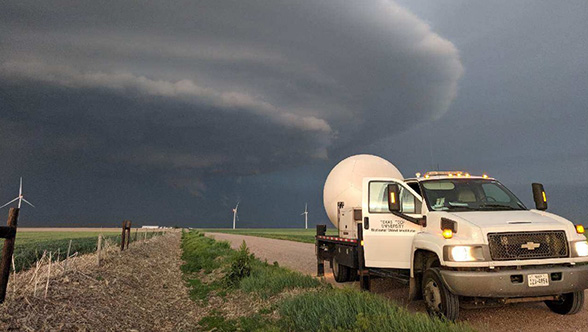
In the modern era, Schroeder said, we now have Doppler radars around the country and a lot more measurements of the storm scale processes. Damage is still happening, lives are still being lost, and scientists at Texas Tech will continue to research on ways to mitigate the damage and make structures safer, he said.
“We understand maybe a little better now than we used to” when and why tornadoes may develop, Schroeder said. Having more modeling capability is the future, Schroeder said. He said he believes researchers will be looking at more numerical work and experimental work that could lead to more tornado-centric standards and codes to keep people safe in the future.
“We're starting to see a new era where it's not just about learning what didn't work. Now it's more about starting to turn the page,” Schroeder said, adding that science will lead to solutions and tornado-resistant construction.
Cooperation ultimately led to the scientists realizing in the 1990s that they could also be researching the positives of wind energy, in addition to the negatives of the hazards of wind.
“Things have just grown, and I think it's grown because if you look at the history, people were open to working together, and we allowed things to evolve organically when it made sense to do so,” Schroeder said. “We were always very open-minded, and because of that, we've always evolved and grew. But it goes back to Kishor, Joe, Jim, Ernie and Richard (Peterson) and so forth having the sort of an openness to work together, explore new ideas from different perspectives, and bring new people in to solve problems.”
